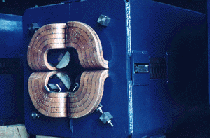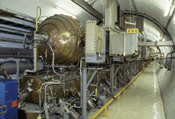


A quadrupole magnet
Technician installing a magnet in CERN's new Antiproton Decelerator (AD) ring.
Example of a Radio-Frequency (RF) accelerating cavities. Here the ones installed for the first phase of LEP 1989-95.
What does the AD consist of?
The AD ring is an approximate circle with a circumference of 188 m. It consists of a vacuum pipe surrounded by a long sequence of vacuum pumps, magnets, radio-frequency cavities, high voltage instruments and electronic circuits. Each of these pieces has its specific function:
- Antiprotons circulate inside the vacuum pipe in order to avoid contact with normal matter (like air molecules), and annihilate. The vacuum must be optimal, therefore several vacuum pumps, which extract air, are placed around the pipe.
- Magnets as well are placed all around. There are two types of magnets: the dipoles (which have a North and a South pole, like the well-known horseshoe magnet) serve to change the direction of movement and make sure the particles stay within their circular track. They are also called "bending magnets". Quadrupoles (which have four poles) are used as 'lenses'. These "focussing magnets" make sure that the size of the beam is smaller than the size of the vacuum pipe.
- Magnetic fields can change the direction and size of the beam, but not its energy. To do this you need an electric field: this is provided by radio-frequency cavities that produce high voltages in synchronicity with the rotation of particles around the ring.
- Several other instruments are needed to perform more specific tasks: two cooling systems "squeeze" the beam in size and energy; one injection and one ejection system let the beam in and out of the machine.


